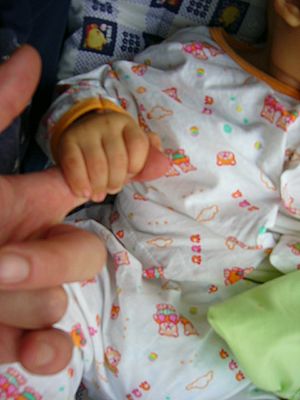Reflex facts for kids
A reflex is a super fast, automatic action your body does without you even thinking about it. It's like your body's quick response system to keep you safe or help you do things. These actions happen because a special message travels quickly from your body part to your spinal cord and back to a muscle, making it react.
A reflex action is an involuntary movement. This means you don't choose to do it. It's a very quick reaction to something that happens, like touching something hot. True reflexes are controlled by something called a reflex arc, which is a special pathway in your nervous system.
Contents
What Are Reflexes?
Reflexes are like built-in programs in your body. They are not learned behaviors; you are born with many of them. They help protect you from harm and keep your body working smoothly. For example, if a bright light shines in your eyes, your pupils automatically get smaller. This protects your eyes from too much light.
Why Do We Have Reflexes?
Reflexes are important for many reasons:
- Safety: They help you react quickly to danger. Imagine touching a hot stove; your hand pulls away before you even feel the pain. This prevents serious burns.
- Balance and Movement: Reflexes help you stay upright and move without falling. For instance, if you trip, reflexes help you catch yourself.
- Body Functions: Many internal body processes, like breathing, digestion, and your heart beating, involve reflexes. You don't have to think about these things for them to happen.
How Do Reflexes Work?
Reflexes work through a pathway called a reflex arc. This arc is a simple circuit in your nervous system. Here's how it generally works:
- Stimulus: Something happens that triggers the reflex. This could be heat, pressure, light, or a stretch in a muscle.
- Sensory Neuron: Special nerve cells called sensory neurons detect the stimulus. They send an electrical message from the body part (like your finger) towards the spinal cord.
- Spinal Cord (Integration Center): When the message reaches the spinal cord, it usually doesn't go all the way up to your brain for a decision. Instead, the spinal cord quickly processes the message. Sometimes, another nerve cell called an interneuron helps connect the sensory neuron to the motor neuron.
- Motor Neuron: The spinal cord sends a new message back out through a motor neuron. This neuron carries the message away from the spinal cord to a muscle or gland.
- Effector (Muscle/Gland): The muscle or gland receives the message and reacts. For example, a muscle might contract to pull your hand away, or a gland might release a chemical.
This whole process happens incredibly fast, often in a fraction of a second. The message only goes to the spinal cord and back, which is why it's so much quicker than actions that require your brain to think about them.
Types of Reflexes
There are different ways to group reflexes, but here are a few common types:
Inborn Reflexes
These are reflexes you are born with. They are also called innate reflexes or unconditioned reflexes. They don't need to be learned.
- Withdrawal Reflex: Pulling your hand away from something hot or sharp.
- Pupillary Reflex: Your pupils changing size in response to light.
- Suckling Reflex: Babies automatically suck when something touches their lips.
- Rooting Reflex: Babies turning their head and opening their mouth when their cheek is stroked, looking for food.
- Knee-Jerk Reflex: When a doctor taps below your kneecap, your leg kicks out. This is a stretch reflex that helps maintain posture.
Conditioned Reflexes
These are reflexes that you learn over time. They are also called acquired reflexes or conditioned responses. They are not present at birth but develop through experience.
- Driving a Car: After a lot of practice, many actions like braking or steering become almost automatic reactions to traffic situations.
- Playing a Musical Instrument: With practice, your fingers move automatically to play notes without you having to consciously think about each one.
- Salivating at the Smell of Food: While salivating to food in your mouth is inborn, salivating just from the smell or thought of food is a conditioned reflex.
Reflexes in Daily Life
Reflexes are happening all the time, even when you don't notice them. They are a vital part of how your nervous system keeps you safe and allows you to interact with the world around you. From blinking your eyes to catching yourself when you stumble, reflexes are constantly at work, protecting you and helping you move through your day.
See also
 In Spanish: Reflejo para niños
In Spanish: Reflejo para niños


